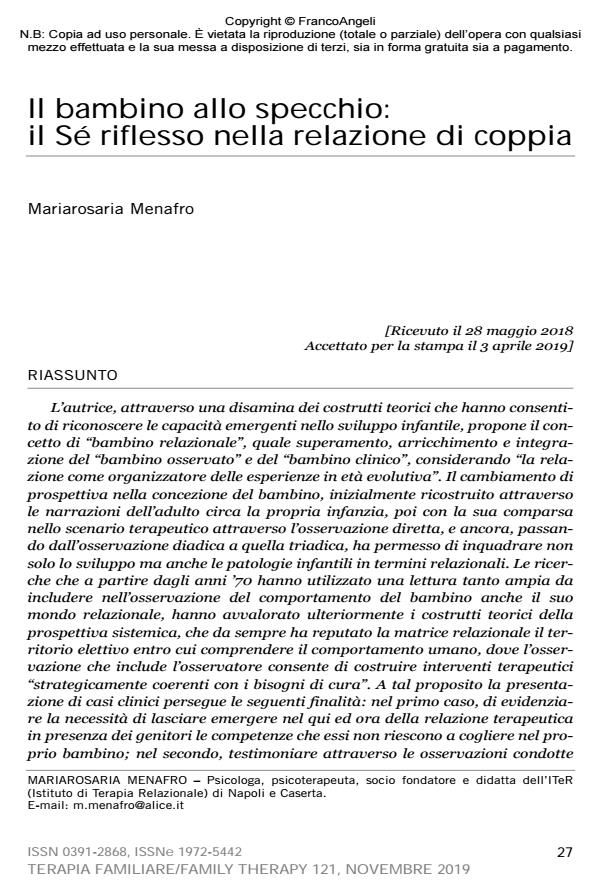The child in the mirror: the self reflected in the couple relationship
Journal title TERAPIA FAMILIARE
Author/s Mariarosaria Menafro
Publishing Year 2020 Issue 2019/121
Language Italian Pages 21 P. 27-47 File size 96 KB
DOI 10.3280/TF2019-121002
DOI is like a bar code for intellectual property: to have more infomation
click here
Below, you can see the article first page
If you want to buy this article in PDF format, you can do it, following the instructions to buy download credits

FrancoAngeli is member of Publishers International Linking Association, Inc (PILA), a not-for-profit association which run the CrossRef service enabling links to and from online scholarly content.
The author, analyzing the theoretical constructs that have dimostrated the emerging capacities during child development, proposes the concept of "relational child"as an improvement and integration of "observed child" and "clinical child", considering "the Relation as the Organizer of experience in developmental age". The concept of the "Child" has almost completely changed: the first perspective was based on the adults reconstructions about this period, then the children were directly observed in clinical settings in a dyadic relation, and later in a triadic interaction that allowed to frame development and childhood psychopathology in relational terms. Since the 1970s, research that included observing the behavior of children in their relational world has validated the systemic theoretical constructs that consider the relational matrix to be fundamental for understanding human behavior and include the observer as an object of observation for building therapeutic interventions "strategically consistent with care needs". The following clinical cases have different objective: in the first case, author highlights the importance in therapeutic relation to bring out in presence of parents the competences that they can’t reveal in their children; in the second case, she reports the ability of a five-years-old girl to anticipate her future emotional experiences (mentalization); in the third case she propose a systemic interpretation of child development highlighting the multifactorial dimension of construction of self and its connection with familial dynamic: she reports the "trigeneration" resonances of a two-year-old patient who seems to reflect her parents’ expectations, as if the self were reflected in the couple relation.
Keywords: Relational child, mentalization, childhood psychotherapy, "self" development, triangular space, therapeutic techniques.
- La magie de l’enfant dans la thérapie familiale pp.231 (ISBN:9782710146360)
Mariarosaria Menafro, Il bambino allo specchio: il Sé riflesso nella relazione di coppia in "TERAPIA FAMILIARE" 121/2019, pp 27-47, DOI: 10.3280/TF2019-121002